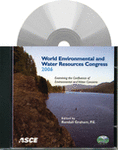Combination of Drainage Water Management, Cover Cropping, and Wetland Diversion as a Suite of BMPs to Reduce Nitrogen Loss from Cropland
Publication: World Environmental and Water Resource Congress 2006: Examining the Confluence of Environmental and Water Concerns
Abstract
Conventional surface and subsurface drainage practices and common crop fertilization methods have resulted in increased nitrate losses from agricultural fields to surface waters. However, research results from several humid region locations over the past 20 years have documented that controlled subsurface drainage can significantly reduce (40–50%) nitrate-N losses carried in drainage discharge from cropland. Other research has shown the benefit of post-harvest cover cropping as a nitrogen sink, which also reduces nitrate loss. Research has also shown that nitrate carried in stream flow can be significantly reduced by diverting the stream flow through wetland resource areas before routing it back into the main stream. This paper discusses the combination of these into a suite of BMPs to reduce nitrate losses from cropland for improved stream water quality. Application of this suite of practices throughout the Mississippi River Basin could significantly reduce the amount of nitrate carried to the hypoxic zone in the Northern Gulf of Mexico. A cooperative action group, Drainage Water Management Systems Task Force (ADMS-TF) was formed in 2002 by employees of USDA's Agricultural Research Service (ARS), Natural Resources Conservation Service (NRCS), Cooperative State Research, Education, and Extension Service (CSREES), and University research and extension partners to promote and implement drainage management (controlled drainage) on cropland to reduce nitrate losses in drainage discharge. The initial efforts of the Task Force, conducted cooperatively with drainage industry representatives, were in eight humid region Midwestern States of IA, IL, IN, OH, MI, MN, MO, & WI. Best management practices (BMPs) of cover cropping and wetland diversion are also recommended as complementary practices to further reduce nitrate load in receiving waters and improve surface water quality. Retrofitting existing subsurface drainage systems for managed (controlled) operation is a major goal of the Task Force. The vast majority of all subsurface drains installed to date in the United States are conventional subsurface drains with gravity flow outlets to the full depth of the drain. An outlet control structure (e.g., overflow weir, valve, or pumped sump) can be used to convert it to a drainage water management system. For new installations, the Task Force has recommended shallower drains, for example no deeper than 3.0 ft., thus reducing the potential for nitrate-N loss in discharge if an outlet control is not installed. These same principals also apply to deep drainage ditches, and the potential benefits of managing (controlling) ditch drainage systems are also being explored by Task Force members.
Get full access to this chapter
View all available purchase options and get full access to this chapter.
Information & Authors
Information
Published In
Copyright
© 2006 American Society of Civil Engineers.
History
Published online: Apr 26, 2012
ASCE Technical Topics:
- Agriculture
- Best Management Practices (BMPs)
- Chemical compounds
- Chemicals
- Chemistry
- Drainage
- Drainage systems
- Environmental engineering
- Irrigation engineering
- Nitrates
- River engineering
- River systems
- Salts
- Stormwater management
- Subsurface drainage
- Surface drainage
- Water and water resources
- Water management
- Water treatment
- Wetlands (fresh water)
Authors
Metrics & Citations
Metrics
Citations
Download citation
If you have the appropriate software installed, you can download article citation data to the citation manager of your choice. Simply select your manager software from the list below and click Download.
